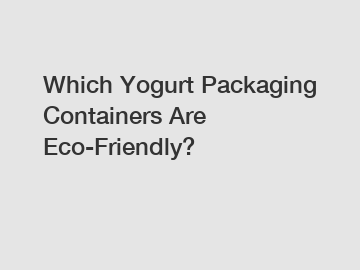Jan. 30, 2024
Packaging & Printing
Which Yogurt Packaging Containers Are Eco-Friendly?
Yogurt has gained immense popularity as a healthy and delicious snack option. However, the environmental impact of yogurt packaging has raised concerns among eco-conscious consumers. With various packaging options available in the market, it becomes crucial to determine which yogurt packaging containers are truly eco-friendly. In this article, we will explore the environmental aspects of different types of yogurt packaging, delve into their sustainability credentials, and discuss the significance and impact of eco-friendly choices.
## Plastic Containers: A Convenient yet Concerning Choice.

Plastic containers are the most commonly used packaging option for yogurt due to their convenience and affordability. However, the impact of plastic on the environment cannot be ignored. Plastic containers are non-biodegradable and take hundreds of years to decompose. Their production involves the extraction of fossil fuels, a process that contributes to greenhouse gas emissions and depletes natural resources. Additionally, improper disposal of plastic containers leads to pollution in oceans and landfills.
## Paperboard Containers: A Promising Alternative.
In recent years, paperboard containers have gained attention as a more sustainable alternative to plastic. Made from renewable resources, such as wood pulp, paperboard is biodegradable and can be recycled. It requires less energy to produce compared to plastic containers, resulting in lower carbon emissions. Moreover, many paperboard containers are now coming from certified sustainable sources, ensuring responsible forest management.
However, the sustainability of paperboard containers depends on various factors. The presence of a thin layer of plastic coating on the inside to prevent leakage can impact the recycling process. Consumers must ensure proper recycling facilities are available in their area to maximize the environmental benefits of paperboard containers. Furthermore, the sourcing and production practices of paperboard should be scrutinized to avoid deforestation and ensure a truly eco-friendly choice.
## Plant-based Containers: The Future of Yogurt Packaging.
Plant-based containers, often made from materials like cornstarch or sugarcane fiber, are emerging as an innovative and eco-friendly solution. These containers are fully biodegradable and compostable, offering a promising alternative to plastic and paperboard. They can be disposed of in a composting facility, where they break down into organic matter without releasing harmful toxins or contributing to pollution.
The production of plant-based containers requires fewer fossil fuels and emits fewer greenhouse gases compared to plastic containers. Additionally, their manufacturing process relies on renewable resources, reducing dependence on finite sources like petroleum. The adoption of plant-based containers not only addresses the plastic waste problem but also contributes to a more sustainable and circular economy.
## Significance and Impact of Eco-friendly Choices.
Choosing eco-friendly yogurt packaging containers is not merely an individual responsibility but also a significant step towards protecting our planet. By opting for containers that are biodegradable, recyclable, or compostable, consumers can reduce their carbon footprint and contribute to waste reduction. Encouraging companies to prioritize sustainable packaging options will drive innovation and lead to a more environmentally conscious industry.
Moreover, the impact of eco-friendly choices extends beyond yogurt packaging. It sets a precedent for other food and beverage industries to adopt sustainable packaging practices. By creating a demand for eco-friendly solutions, consumers can influence manufacturers to explore greener alternatives and move towards a circular economy, where resources are efficiently used and waste is minimized.
In conclusion, while plastic containers remain the most commonly used yogurt packaging option, their negative impact on the environment cannot be ignored. Paperboard containers offer a promising alternative, but careful consideration must be given to their sourcing and recycling capabilities. Plant-based containers, on the other hand, present an innovative and eco-friendly solution, contributing to waste reduction and a more sustainable future. By making informed choices and prioritizing eco-friendly yogurt packaging, we can protect the environment and work towards a greener planet.
If you want to learn more, please visit our website 500ml Ice Cream Tubs, Iml ice cream tubs Manufacturer, 500ml ice cream Container.
Previous: Which Type of Glass Is the Safest for Pharmaceuticals?
Next: Which Innovations Make Multi Well Plates More Sustainable?
If you are interested in sending in a Guest Blogger Submission,welcome to write for us!
All Comments ( 0 )